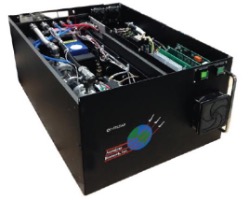Aerodyne TILDAS CO and N2O Instrument

An Aerodyne CS-108 carbon monoxide (CO) and nitrous oxide (N2O) instrument was acquired in 2017. The quantum cascade laser (QCL) sensor operates on the principle of direct absorbance of infrared radiation near 4.6 µm. The optical spectrometer consists of a thermoelectrically cooled QCL laser source, alignment and wavelength calibration optics, photodetector, and an approximately 0.5 L Herriott cell that provides a 76-m path length. The optical bench is housed in an unsealed, vibrationally isolated aluminum box.
To improve accuracy of airborne observations, the In-situ Photochemical Tracers group implemented a continuous purge of the optical housing using dry air scrubbed in order to remove residual CO and thereby eliminate the contribution of ambient pressure CO and N2O absorbance to the background spectral fit.
Upon implementing this configuration change and optimization of spectral fit parameters for improved CO quantification, the instrument underwent environmental chamber and null test flight characterization to confirm adequate performance in airborne applications. This instrument was first deployed during the 2018 WE-CAN field campaign. In 2019 it was certified for GV operation in order to undergo high altitude GV flight tests in preparation for the 2022 ACCLIP experiment. In laboratory and airborne operation, a 1-s precision of 0.3 ppbv is observed for each measurand. During airborne operations the instrument typically performs with a ± 1 ppbv overall uncertainty in N2O and CO determinations.

Hourly in-flight calibrations of 2-4 minute duration are typically conducted with 1-2 working standards and in coordination with other sensors. Working standard concentrations are traceable to WMO network by laboratory calibration against NOAA GMD primary standard suite maintained by RAF.